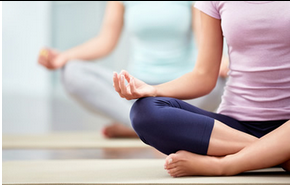 Pranayama means ‘to stretch the breath’. It is prudent to advance gradually in any form of stretching that we do with the physical body. When stretching the physical body the ligaments act as elastic tissue and have a great capacity to stretch, provided the extent of flexibility is approached and accommodated gradually by the entire organism. At the same time, the muscle tissue needs to be strong enough to provide adequate support for the increased flexibility, maintaining a healthy balance. If ligaments are stretched too rapidly beyond their limit injury results, ranging from tearing of a few fibres to a complete ligamentous tear, requiring an extended recovery period. When stretching the breath, it seems logical that the same caution should be applied with the same aim of maintaining balance in the system as a whole.
Pranayama means ‘to stretch the breath’. It is prudent to advance gradually in any form of stretching that we do with the physical body. When stretching the physical body the ligaments act as elastic tissue and have a great capacity to stretch, provided the extent of flexibility is approached and accommodated gradually by the entire organism. At the same time, the muscle tissue needs to be strong enough to provide adequate support for the increased flexibility, maintaining a healthy balance. If ligaments are stretched too rapidly beyond their limit injury results, ranging from tearing of a few fibres to a complete ligamentous tear, requiring an extended recovery period. When stretching the breath, it seems logical that the same caution should be applied with the same aim of maintaining balance in the system as a whole.
In the physical mechanics of breathing, we are moving many body tissues as we take air into the lungs. The lungs themselves, the pleural lining around the lungs and between the fissures, the fascial tissue between the lungs and all surrounding organs and structures – heart, oesophagus, diaphragm, ribs, sternum, spine – particularly the cervical spine from which the lungs are suspended. Not forgetting that all the nerves and blood vessels are housed in this elastic fascial tissue that surrounds just about every structure in the body. Also the structures affected by these adjacent structures, in particular all the abdominal organs that are affected by the diaphragm as it moves with the breath.
Injury patterns and restrictions in any of these structures can become more apparent when the breath is stretched further than accustomed. A restricted rib or cervical vertebra, e.g., may start to move more freely in response to gently expanding the breath. Gradually, with careful expansion of the breath, deeper tensions may start to release.
When deep fascial tissue tensions in and between organs are released therapeutically, they can release deep tensions that may have been held in the body for a long period of time, without the person being consciously aware of them. This requires a deep adjustment within the whole system to regain an equilibrium that is ultimately beneficial though perhaps at first a little disorientating. I feel that a similar release can be gained with careful Pranayama. If the stretch of the breath and the tissues is gradual, the body can easily accommodate the micro changes whilst maintaining equilibrium.
Imagine the effect of tension in the pleural tissue. Suppose that this tension pulls through to the diaphragm, affecting the breathing generally and the entire abdominal system via the restricted diaphragmatic movement. It may also pull through to the psoas muscle affecting the kidneys, which normally travel 600 metres along the psoas every day. The tension in the psoas muscle may pull unevenly on the hip and the lumbar spine affecting the nerve distribution to surrounding muscles and organs. The body considers organs and blood vessels to be more important than joints for survival, so it is happy for the person to have an adapted posture creating tension in a joint in order to make space to minimise or avoid any effective tension in an organ.
Imagine now that the breath is suddenly stretched, releasing all the tension in the pleural tissue. The dynamics of the forces held throughout the body to help compensate for this tension are now no longer required. Suddenly, the accommodation and adaption around the stresses on the diaphragm, kidneys, lumbar spine, hip and perhaps reflex nerve responses all need to change, yet the change is far too great for the body to accommodate, resulting in imbalance. I feel the principal is similar to overstretching a ligament by excessive physical stretching, just that the physical stretching is this time accomplished with the breath.
Gentle breathing techniques allow the person to develop control over the breathing mechanism and the rhythm of the breath; bonding with the lobes of the lungs and the breath whilst having a beneficial effect on the body structures and circulation. The use of physical postures with this breath further develops the strength of the breath. There is also a powerfully relaxing effect on the large Solar Plexus nerve centre, our emotional brain, helping to keep it decongested.
We are happy to advise you on your health matters and offer a free 15 minute joint and spinal check, without obligation.
Lin Bridgeford DO KFRP MICAK MICRA FSCCO MSc
Registered Osteopath & Kinesiologist & Yoga Teacher
Aether Bios Clinic
Saltdean
01273 309557
07710 227038
